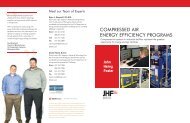The Turbo Air® 3000 Centrifugal Compressor Compressor Handbook
The Turbo Air® 3000 Centrifugal Compressor Compressor Handbook
The Turbo Air® 3000 Centrifugal Compressor Compressor Handbook
You also want an ePaper? Increase the reach of your titles
YUMPU automatically turns print PDFs into web optimized ePapers that Google loves.
<strong>The</strong> <strong>Turbo</strong> Air <strong>3000</strong> <strong>Centrifugal</strong> <strong>Compressor</strong> Operator’s Manual<br />
Block Valve<br />
All compressor installations must include a block valve to insulate the compressor from the remainder of<br />
the pressure system in case of a check valve failure. <strong>The</strong> user must supply the block valve, which must<br />
be installed after the check valve.<br />
A—16<br />
WARNING:<br />
Whenever the compressor is being serviced, be certain to close and lock the block valve.<br />
<strong>The</strong>se measures are necessary to protect the compressor whenever the check valve is being<br />
serviced or otherwise not functional.<br />
Automatic Block Valve Option<br />
<strong>The</strong> Automatic Block Valve option fits between two 150-lb. ANSI raised-face flanges in the discharge air<br />
piping. <strong>The</strong> recommended installation is after the aftercooler (if so equipped) and at least four pipe<br />
lengths beyond the discharge check valve. While the valve orientation is at the installer’s discretion,<br />
accessibility should be considered if the Automatic Block Valve is to be used as a lockout device during<br />
compressor service.<br />
<strong>The</strong> valve actuator requires a 60-psig air supply for a three-stage compressor or a 30-psig air supply for<br />
a two-stage compressor. If available, use the instrument air supply; alternatively, tap the pipe located<br />
immediately upstream of the valve itself. <strong>The</strong> supply air should be connected to the lockout valve on<br />
the block valve assembly. Verify correct operation of the Automatic Block Valve at the initial startup,<br />
since valve malfunction may cause compressor surging. Refer to Cooper <strong>Turbo</strong>compressor EDR-A-008,<br />
Automatic Block Valve, for additional information on the Automatic Block Valve option.<br />
Control Valve Piping<br />
Depending on the control method being applied, the <strong>Turbo</strong> Air <strong>3000</strong> will either completely or partially<br />
unload whenever the capacity of the compressor exceeds the compressed air system’s demand. Under<br />
AUTO-OFFLINE control, the compressor is unloaded by completely bypassing the compressed air system<br />
and venting discharge air back to the inlet of the compressor or out to atmosphere. In other cases, a<br />
portion of the discharge air is partially vented or blown-off in order to maintain Constant Pressure or<br />
constant mass flow into the compressed air system.<br />
Bypass Valve<br />
<strong>The</strong> AUTO-OFFLINE Control method utilizes a pop-action bypass valve (BPV). <strong>The</strong> BPV operates in either a<br />
fully open or fully closed position. <strong>The</strong> compressor owner/installer is responsible for the proper installation<br />
of this control valve (which is shipped separately) unless the Mounted Bypass Valve option is<br />
purchased. (Refer to the relevant heading for additional information about that option.)<br />
Modulating Blow-Off Valve (MBOV)<br />
All control methods may utilize a modulating blow-off valve (MBOV) which operates in any position<br />
from fully closed to fully open. A pneumatic actuator, and I/P transducer, a volume booster and a filter<br />
regulator all come mounted and integrally piped to the valve body as a complete assembly. <strong>The</strong> owner/<br />
installer is responsible for the proper installation of the MBOV, which is shipped separately.



